The Renewable Energy Future Is Here--It's Just Unevenly Distributed
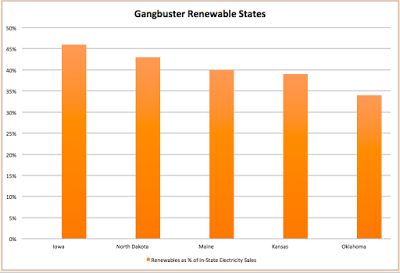 Renewable MonstersElectricity production data is out from the US Energy Information Agency for the first half of 2016. Nation-wide, renewables (including distributed solar but not hydro) accounted for 10.2% of electricity sales, up from 8.4% the first half of 2015. The increase in renewables nationally is making headlines, but it’s even more instructive to drill down to the state level where we find some states are making phenomenal headway, and others are making none at all.
Renewable MonstersElectricity production data is out from the US Energy Information Agency for the first half of 2016. Nation-wide, renewables (including distributed solar but not hydro) accounted for 10.2% of electricity sales, up from 8.4% the first half of 2015. The increase in renewables nationally is making headlines, but it’s even more instructive to drill down to the state level where we find some states are making phenomenal headway, and others are making none at all.I like to look at renewables as a percent of electricity consumed rather than generated, because if a state generates little of its own power, it may still be responsible for ginormous carbon emissions that it’s simply shoved on to someone else. On the flip side, some states are already meeting a high percentage of their electricity needs via renewables, a fact masked by the large amounts of electricity they generate for export to other states. In addition, locally-produced power means lower transmissions losses, reducing the amount of electricity needed to be generated in the first place.
So, let’s dive in. First we’ll evaluate non-hydro renewable electricity production, including distributed solar, as a percent of total consumption for the first half of 2016. The top states are Iowa (46%), North Dakota (43%) and Maine (40%). Iowa and North Dakota both burnt coal in order to export electricity, although the amount dropped by 32% in Iowa and 13% in North Dakota. The next two states that have really stepped up renewable production as a percent of electric consumption the first half of this year are Kansas (39%) and Oklahoma (34%). Both of these states also burnt coal in order to export electricity, but much less than in 2015—21% percent less for Kansas and 44% percent less for Oklahoma. Overall the US burnt 20% less coal to produce electricity the first half of 2016 over the first half of 2015.
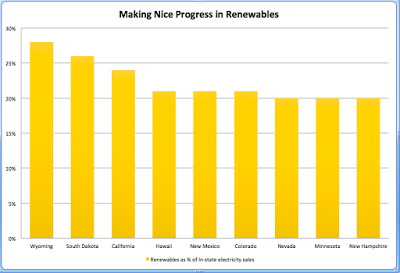 Looking good!The second tier of states in renewable production as a percent of electricity consumption are: Wyoming (28%), South Dakota (26%), California (24%), Hawaii (21%), New Mexico (21%), Colorado (21%), Minnesota (20%), New Mexico (20%) and New Hampshire (20%.) Where is Texas, you might ask? Even though Texas has increased its renewables production by the largest absolute amount (i.e. phenomenally), because it’s such a populated state, it’s still only meeting 17% of its electricity consumption via renewables, putting it in the third tier of states, as outlined in the table below.
Looking good!The second tier of states in renewable production as a percent of electricity consumption are: Wyoming (28%), South Dakota (26%), California (24%), Hawaii (21%), New Mexico (21%), Colorado (21%), Minnesota (20%), New Mexico (20%) and New Hampshire (20%.) Where is Texas, you might ask? Even though Texas has increased its renewables production by the largest absolute amount (i.e. phenomenally), because it’s such a populated state, it’s still only meeting 17% of its electricity consumption via renewables, putting it in the third tier of states, as outlined in the table below.Oregon 19% Vermont 18% Texas 17% Idaho 16% Montana 16% Nebraska 13% Washington 12% Illinois 10%
For the US as a whole, renewables (including distributed solar) made up 10.2% of electricity sales the first half of 2016 compared to 8.4% the first half of 2015.
Though many states have made considerable progress with renewables, some have not. States that have made a particularly poor showing (2% or less of their electricity from renewables) are Ohio, Missouri, Delaware, Kentucky, Tennessee, New Jersey, Massachusetts, Rhode Island and Florida. I will point out that Missouri, Delaware, Kentucky, Tennessee and Florida have solar insolation levels equivalent to one of the sunniest countries on earth, Spain. Ohio and Missouri have decent wind in the western halves of their states, while New Jersey, Massachusetts and Rhode Island have access to substantial wind offshore.
Due to better rainfall, 2016 has been a good year for hydro. While hydro has its own environmental problems, it provides a nice adjustable baseload that can offset the intermittency of renewables, as well as potential for large-scale energy storage via pumped hydro, although this comes with a 20% efficiency loss. If we add hydro to renewables, we get a bit different picture. Our stellar states then become:
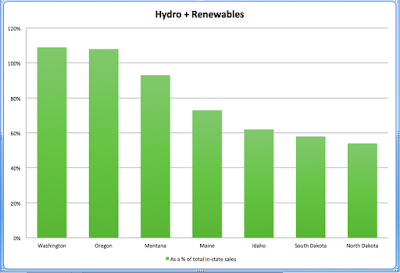 Lots of juice
Lots of juiceYes, both Washington and Oregon created more electricity via hydro plus renewables than they consumed the first half of 2016. Unfortunately both states also burnt small amounts of coal so that they could export additional electricity. Montana and North Dakota burnt a substantial amount of coal so that they could export electricity. Any state that wants to reduce its carbon emissions should not import electricity from states that burn coal. I’m looking at you, California, the greatest electricity-importing state in the country. Although, to be fair, each year California is producing more of its own electricity and importing less. The first half of 2016, California imported 9% less electricity than the first half of 2015.
Other states that produced more than a third of their domestic electricity consumption via renewables + hydro the first half of 2016 were:
Iowa 48% Vermont 44% Kansas 39% Oklahoma 39% California 36% New Hampshire 35% Wyoming 34%
Nationally, the US produced 19% of the electricity it consumed via renewables + hydro.
In order avoid catastrophic climate change, our civilization needs to become vastly more energy efficient (see: Efficiency Is Not the Enemy of Resiliency) and replace fossil fuel use with renewable electricity (see: Obey the Law of Exergy (Time to Go All Electric.)) How much renewable + hydro electricity per capita/day will each state need in order to meet all its energy needs, including heating, cooling, industry and transportation? Currently, if we take all primary energy consumption in the US and convert it to kilowatt-hours, it comes to 230 kwh/capita/day. During the first half of 2016, the US as a whole produced 6 kwh/capita/day through renewables + hydro. Even our very best state, Washington, produced only 37 kwh/capita/day via renewables + hydro. Three other states came close: North Dakota (35), Montana (34), Oregon (34). The next four highest were: Wyoming (26), Idaho (23), South Dakota (22) and Iowa (20.) Sadly, twelve states produced 2 or fewer kwh/capita/day via renewables + hydro: Connecticut, Massachusetts, Rhode Island, New Jersey, Pennsylvania, Ohio, Missouri, Delaware, Florida, Maryland, Virginia, and Mississippi. If you live in any of these states, you have serious cause for concern.
Yikes! We’ve got a long ways to go. But it’s not as bad it seems. If we look to Europe, we see that through efficiency many countries enjoy a quality of life arguably better than the US while consuming the energy equivalent of 90 - 120 kwh/capita/day. (see: An Energy Diet for a Healthy Planet .) And some US states are energy intensive largely due to extracting/processing/refining fossil fuels. Without coal mining, oil production, and oil refining, per capita energy use will drop dramatically in energy-gobbling Louisiana, Wyoming, North Dakota and Alaska. Even Texas should see a nice drop.
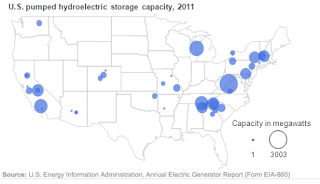 Pump it upIn order to integrate a high level of intermittent renewables into the electric grid, every state is going to need substantial energy storage, whether it takes the form of electrochemical batteries, ice, molten salt, hydrogen, flywheels, compressed air, pumped hydro, or seasonal thermal energy storage. Most likely, as the price of wind and solar continue to drop, states will create excess capacity of both forms of electricity production. On windy days, when all grid demand is met, excess electricity can be directed to create hydrogen through electrolysis, which can be used as fuel for ferries or cargo ships, or in the production of inorganic fertilizer. Excess solar capacity, much easier to predict, can be directed during the peak of the day to charge batteries, pump water uphill, heat water in buildings for the evening heating load (winter), or create ice or chilled water in buildings for the evening cooling load (summer.) Early leaders in energy storage are California, New York, Hawaii and Arizona.
Pump it upIn order to integrate a high level of intermittent renewables into the electric grid, every state is going to need substantial energy storage, whether it takes the form of electrochemical batteries, ice, molten salt, hydrogen, flywheels, compressed air, pumped hydro, or seasonal thermal energy storage. Most likely, as the price of wind and solar continue to drop, states will create excess capacity of both forms of electricity production. On windy days, when all grid demand is met, excess electricity can be directed to create hydrogen through electrolysis, which can be used as fuel for ferries or cargo ships, or in the production of inorganic fertilizer. Excess solar capacity, much easier to predict, can be directed during the peak of the day to charge batteries, pump water uphill, heat water in buildings for the evening heating load (winter), or create ice or chilled water in buildings for the evening cooling load (summer.) Early leaders in energy storage are California, New York, Hawaii and Arizona.The amount of electricity a state will ultimately need in order to efficiently and comfortably meet its energy demand will no doubt depend on its climate, population density, and amount of heavy industry. States like California and Hawaii with low heating and cooling loads might get by with 80 kwh/capita/day, as might states with high population densities that are already frugal energy users, like New York, Rhode Island, Massachusetts and Connecticut. Rural states with intense winters like North and South Dakota may need 120 kwh/capita per day. Still, most Midwest and Rocky Mountain states, home to prodigious wind resources, could easily produce all the electricity they need from wind and hydro, plus have ample for export. Out of thirteen states windy states (MT, WY, CO, NM, ND, SD, KS, NE, IA, TX, OK, MN, MO), eleven of them have already made substantial progress in taking advantage of their renewable resources. Two haven’t. (I’m looking at you Nebraska and Missouri.)
The Pacific Northwest—Oregon, Washington and Idaho--with its hydro and nice pockets of wind should be able to reach 100 kwh/capita/day without much trouble. California and Texas have put the most effort into renewables and produce the greatest absolute amount of electricity from renewables by far. But because their large populations, reaching even 80 kwh/capita/day is going to be an effort. At the moment, both only produce 6 kwh/capita/day by renewables + hydro.
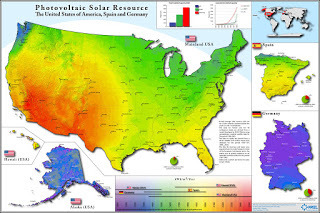 Alaska beats GermanyHawaii has great solar and great wind and pays ridiculous sums for its imported fossil fuels. However much its utilities fight it, I expect Hawaii will be energy self-sufficient within a decade. Remarkably, Alaska has better solar insolation than Germany, but since it also has fabulous wind resources, the odds are high that’s the direction it’ll take.
Alaska beats GermanyHawaii has great solar and great wind and pays ridiculous sums for its imported fossil fuels. However much its utilities fight it, I expect Hawaii will be energy self-sufficient within a decade. Remarkably, Alaska has better solar insolation than Germany, but since it also has fabulous wind resources, the odds are high that’s the direction it’ll take.It’s the South, along with Pennsylvania, New Jersey, Ohio, and Missouri that appear to have the most challenges ahead, mostly because they have poor on-shore wind resources (with the exceptions of western Missouri, western Ohio and pockets of the Appalachians) and, with the exception of North Carolina and New Jersey, haven’t made much of an effort to make use of the really very good solar resources they do have. This inertia will impact their economies hugely over the next decade. Over sixty major corporations have committed to power themselves with 100% renewable energy, including Google, Hewlett-Packard, Adobe, Johnson and Johnson, Mars, Microsoft, Nike, P&G, Salesforce, Steelcase, Unilever and Walmart. None of them expect to lose money from this commitment. As a result, some are already choosing to locate data centers and manufacturing sites in states where such energy is available. Although I favor small and medium-sized businesses over large corporations, it’s foolish for states to believe that continuing to burn fossil fuels for electricity will give them any kind of competitive advantage. Seventeen US cities have already committed to 100% renewable electricity by 2030. However, keeping with the trend, none of them are in the mid-Atlantic or the South, except for Ithaca and East Hampton in New York. States without renewable energy can expect to bleed industries, jobs and even population continuously over the next decade.
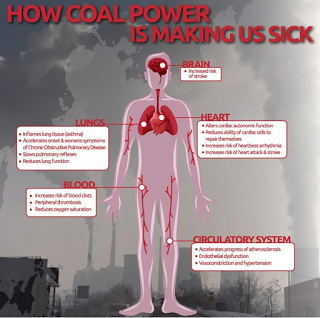 Coal-burning states have long suffered the indirect economic triple-whammy of higher health care costs, higher public health burden, and the environmental degradation that comes with coal power. A study in Michigan found that just nine coal-burning power plants in that state cost Michiganders $1.5 billion in extra health care costs each year. A 2013 study found that each kwh in the US produced by burning coal incurs $.32 of cost in terms of illness, premature mortality, lost workdays, and direct costs to the healthcare system associated with emissions of particulates, NOx, and SO2. (Each kwh from oil incurs $.13 and each kwh from natural gas incurs $.02, although this estimate might be low given the recent natural gas debacle in Aliso Canyon.)
Coal-burning states have long suffered the indirect economic triple-whammy of higher health care costs, higher public health burden, and the environmental degradation that comes with coal power. A study in Michigan found that just nine coal-burning power plants in that state cost Michiganders $1.5 billion in extra health care costs each year. A 2013 study found that each kwh in the US produced by burning coal incurs $.32 of cost in terms of illness, premature mortality, lost workdays, and direct costs to the healthcare system associated with emissions of particulates, NOx, and SO2. (Each kwh from oil incurs $.13 and each kwh from natural gas incurs $.02, although this estimate might be low given the recent natural gas debacle in Aliso Canyon.) As to environmental impact, I’ll mention just a few of the many factors. Thermal power plants consume an enormous amount of water and substantially contribute the water-supply stress of states experiencing drought. When these power plants return warmed water to nearby rivers, lakes and oceans, they harm ecosystems and wildlife through thermal pollution. Coal power plants also produce wicked toxic waste in the forms of coal slurry and coal ash that must be meticulously contained in order to prevent toxic heavy metals from leaching into drinking water, metals that cause cancer, birth defects, reproductive disorders, neurological damage, learning disabilities and kidney disease. Unfortunately, not all coal toxic waste is meticulously contained. Indeed, at least 42 percent of coal waste nationally is kept in unlined ponds or landfills, making leaching likely to occur. And then there’s the long-term impact of dumping CO2 into our atmosphere, and the fact that, due to widespread leaks in natural gas infrastructure, natural gas is almost as bad as coal in terms of greenhouse gas emissions. One would think at least coastal southern states would be worried enough about nuisance flooding to try to prevent sea-level rise, but so far no dice.
Energy companies that produce fossil fuels and utilities that burn the stuff make profits at everyone else’s expense. This is a lucrative business model--of course they don’t want to change! Of course they will spend vast sums on denial, misinformation, and campaign contributions to protect their income streams. Legally, corporations must maximize the best interest of their shareholders, not society at large. They must follow the law, but if laws (often written by those they help elect) allow them to wreak health and environmental havoc, is it any surprise that they do so?
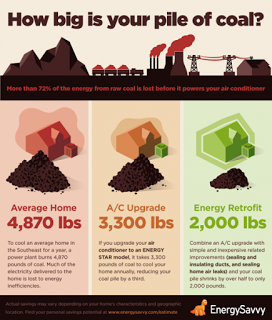 Low hanging fruit aplentyThe price of solar, wind and energy storage is dropping quickly. The levelized cost of both onshore wind and utility-scale solar are already cheaper than all forms of fossil fuel new electric generation, including diesel and natural gas reciprocating engines, gas peaker plants, integrated gasification combined cycle (IGCC), standard coal, and gas combined cycle. They are also both quite a bit cheaper than new nuclear. At the moment we subsidize renewables to even the playing field with fossil fuels only because we subsidize fossil fuels heavily by letting them off the hook on externalities. All these energy subsidies are ridiculously expensive, and, worse, they discourage sensible energy efficiency measures by keeping up the pretense that energy is far cheaper than it actually is. All energy subsidies should go, every single one, but that includes the subsidy of shirking the cost of externalities. If the price of fossil fuels included even half the cost of the negative health and environmental impacts that they impose on society, the US would find itself doubling its energy efficiency with remarkable speed (so much low-hanging fruit!) and transitioning to a largely renewable electric supply within a decade. As it stands, Americans thoughtlessly squander energy right and left, health care costs in the US consume nearly a fifth of our nation’s wealth, Americans have the poorest health in the developed world (largely due to pollution, poor diet, and relying on fossil fuels rather than our bodies to move us even short distances), and environmental costs are left to future generations to pay.
Low hanging fruit aplentyThe price of solar, wind and energy storage is dropping quickly. The levelized cost of both onshore wind and utility-scale solar are already cheaper than all forms of fossil fuel new electric generation, including diesel and natural gas reciprocating engines, gas peaker plants, integrated gasification combined cycle (IGCC), standard coal, and gas combined cycle. They are also both quite a bit cheaper than new nuclear. At the moment we subsidize renewables to even the playing field with fossil fuels only because we subsidize fossil fuels heavily by letting them off the hook on externalities. All these energy subsidies are ridiculously expensive, and, worse, they discourage sensible energy efficiency measures by keeping up the pretense that energy is far cheaper than it actually is. All energy subsidies should go, every single one, but that includes the subsidy of shirking the cost of externalities. If the price of fossil fuels included even half the cost of the negative health and environmental impacts that they impose on society, the US would find itself doubling its energy efficiency with remarkable speed (so much low-hanging fruit!) and transitioning to a largely renewable electric supply within a decade. As it stands, Americans thoughtlessly squander energy right and left, health care costs in the US consume nearly a fifth of our nation’s wealth, Americans have the poorest health in the developed world (largely due to pollution, poor diet, and relying on fossil fuels rather than our bodies to move us even short distances), and environmental costs are left to future generations to pay.As might be expected, there is wide variation in renewable adoption not only between states but between countries. According to BP’s 2016 Statistical Review of World Energy, the US got 6% of its total energy (not just electricity) supply from renewables + hydro. This puts the US behind 24 of the 67 countries for which BP provides detailed information, including China (11%), Vietnam (22%), New Zealand (38%), Sweden (44%), the UK (10%), Italy (16%), Germany (14%), France (8%), Denmark (25%), Norway (67%), Austria (31%), Switzerland (33%), Turkey (14%), Canada (29%), and Brazil (33%). It puts the US behind 23 countries in terms of renewables as a percent of total energy. Indeed, nine countries in the world obtained 10% or more of their total energy from renewables alone in 2016, and this number is increasing each year. In the US, only 3% of the total energy supply came from renewables alone in 2015.
As you can see, some states (and nations) are leaping into a renewable future like mountain goats bounding across alpine meadows. Other states are moving with the speed of a recalcitrant three-toed sloth. The states out in front on this inevitable transition will have more vibrant, diversified, robust economies. They will also have greater energy security in the face of fossil fuel volatility. (Is there anyone who really expects Saudi Arabia to last as a stable country another ten years?) Just as reminder, it takes a couple gallons of diesel to strip mine a ton of Powder River Basin coal (40% of all coal production in the US.) This might not seem like much, but Powder River Basin coal currently only sells for $8.70 a ton. Last week, a gallon of diesel in the Rocky Mountain states cost $2.48. So 57% of the price of coal is eaten up by just by the diesel used to produce it. Any oil price volatility will have an enormous impact on coal prices and/or coal profitability.
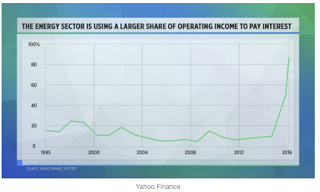 Keep those plates spinningThe Federal Reserve has kept fossil fuel plates spinning the last eight years through endless cheap debt available for sub-prime car loans, corporate stock buy-backs, junk bonds, speculation and even corporate dividend payments. This all works as long as no one is ever expected to pay off debt, just roll it over into ever-increasing amounts new debt. How long a hollowed-out, debt-infested economy can keep going on fumes is anyone’s guess, but when the music stops, states dependent on industries addicted to cheap debt infusions are unlikely to be the ones to thrive.
Keep those plates spinningThe Federal Reserve has kept fossil fuel plates spinning the last eight years through endless cheap debt available for sub-prime car loans, corporate stock buy-backs, junk bonds, speculation and even corporate dividend payments. This all works as long as no one is ever expected to pay off debt, just roll it over into ever-increasing amounts new debt. How long a hollowed-out, debt-infested economy can keep going on fumes is anyone’s guess, but when the music stops, states dependent on industries addicted to cheap debt infusions are unlikely to be the ones to thrive.Food, water, energy and health are essential to a functioning society. (Please note, I’ve specified health, not health care.) The states dawdling on renewables, especially those dependent on burning coal, will suffer heart attacks, pollution, asthma, bronchitis, acid rain and job losses in the near term, and blackouts, brownouts and population loss in the long term. Though renewables are no guarantee of economic vitality, lack of them assures economic decline. Those states with economies heavily dependent on coal mining—Kentucky, Wyoming, Pennsylvania, Montana, and West Virginia--need to read the writing on the wall and embrace the future rather than be dragged into it kicking and screaming.
As Martin Luther King Jr. said, we are all tied together in a single garment of destiny. Everyone alive on this planet a hundred years from now is likely to reap the consequences of climate change and sea-level rise regardless of how much his/her ancestors contributed to the problem. But medium-term, say fifteen years from now, there will variability in outcomes. Just how tattered your state’s part of the garment of destiny will be depends on actions taken now.
Published on September 05, 2016 15:56
No comments have been added yet.



